1Department of Biochemistry, Patna University,
2Post Graduate Department of Botany, Patna University
Corresponding author Email: kumud_rnj@rediffmail.com
Article Publishing History
Received: 01/07/2019
Accepted After Revision: 20/09/2019
Now day’s diabetes has been the endemic in the current society and the history of relying on the herbal is quite long. The present research work explains the efficacy of the ethanolic extract of Gymnema sylvestre (500mg/kg.b.wt) on various parameters like fasting glucose, amylase, lipase, some hematologic parameters. Restoration in the concentration of serum amylase, lipase, and plasma glucose admits positive results. Remodeling of the histology correlates with the Biochemical parameters. Hematological parameters in the present study in the diabetic condition is not much influenced. The result obtained from all those parameters were significant to explain its importance in controlling the diabetes symptom and associated complications. The statistical analysis was done using Prism Figure pad Values represented are mean ± SD (n=5). Significant level was calculated by Tukey multiple range tests compared from the entire column after the ANOVA. The level of significance represented here for diabetic VS treated group having p value p<0.05
Diabetes, Histoarchitecture, Pancreas, Hematology, Enzyme
Thakur K. R, Padmadeo S. R. Evaluation of the Potential of Gymnema Sylvestre on Some Biochemical, Pancreatic Histoarchitecture and Hematologic Parameters in Alloxan Induced Diabetic Wistar Rats. Biosc.Biotech.Res.Comm. 2019;12(3).
Thakur K. R, Padmadeo S. R. Evaluation of the Potential of Gymnema Sylvestre on Some Biochemical, Pancreatic Histoarchitecture and Hematologic Parameters in Alloxan Induced Diabetic Wistar Rats. Biosc.Biotech.Res.Comm. 2019;12(3). Available from: https://bit.ly/31HAfcc
Copyright © This is an Open Access Article distributed under the Terms of the Creative Commons Attribution License (CC-BY). https://creativecommons.org/licenses/by/4.0/, which permits unrestricted use distribution and reproduction in any medium, provided the original author and sources are credited.
Introduction
Diabetes mellitus is characterized by chronic hyperglycemia with disturbance of carbohydrate, fat and protein metabolism resulting from dysregulated insulin secretion, insulin action or both. Diabetes causes heavy annual economic burden to the patient, and its treatment is carried out with several other serious symptom like weight gain, obesity and increased toxicity to the various organ. Practicing of modern medicine to bring glucose to the normal level increases chance to obesity and resultant low grade inflammation pertaining to insulin resistance (Anne et a., 2015, Saltiel and Olefsky, 2017, Ruiz et al., 2019, Hooda et al., 2019).
Type 2 diabetes mellitus is characterized by peripheral insulin resistance and relative insulin deficiency, which may range from predominant insulin resistance and relative insulin deficiency to predominant insulin secretory defect with insulin resistance (Patel and Mishra (2011). Diabetes mellitus is caused by the abnormality of carbohydrate metabolism which is linked to low blood insulin level insensitivity of target organs to insulin (Maiti et al, 2004). Diabetes complications are the major causes of mortality morbidity in the western countries (Leahy, 2005). All those complication is caused due to excessive presence of glucose in the blood and this leads to glycosylation of major proteins causing misbehaved homeostatic regulation (Dotz et al 2018).
The condition of altered glucose regulation is caused due to altered insulin formation, hormonal imbalance that controls glucose homeostasis leads to difficulty in achieving good control (Azari et al., 2017).Pancreas is an elongated gland, consisting of head, body and tail. It is a myxocrine gland, of which exocrine part produced digestive enzymes whereas endocrine gland produces hormones, through islet of Langerhans, (Longnecker and Daniel (2014). Secretary cells are acinus, or tubuloacinus cell. Beta cells are at the centre of the Langerhans while alpha cell are at the periphery of the beta cells (Korc et al, 1981,1978, Chen et al, 2017).
Exocrine gland is interconnected with network of ductile system (Ballian and Brunicardi, 2007). Acinar cell are the simple cuboidal epithelial cell (Cesmebasi et al, 2017). Blood vessel network in the pancreas is uniquely designed. In the islet of Langerhans, β cell receives the blood first through arterioles, and arterioles drain its blood firstly in to the centre through fenestrated capillaries where β cell reside, (Covantev et al., 2019).
Failure in pancreatic β cells occurs very early red. Study led out by (Gastendelli et al., 2013) found that person diagnosed with IGT, by the time he had already lost >80% of his pancreatic β cells function. In an another study it was mentioned deficiency in the β cell mass in type II Diabetes and this was due to stress mediated apoptosis of cells (Chandirasegaran et al., 2017). It was also found that obese individuals had 60% less β cell relative to the non diabetic obese (Butler et al., 2003).
Materials and Methods
For the present research work healthy wistar rats (Rattusnorvegicus) were selected and provided anambient physical and physiological condition as per the standard protocol and all the experimental protocol was carried based on the guideline adopted by Mahavir Cancer Sansthan ethical committee, Phulwarisariff Patna.
Feeding
The laboratory rats were fed on laboratory prepared enriched bread constitutes wheat flour, jaggery, powdered milk and gram flour. For providing vitamin supplement they were fed with carrot, sprouted gram and sprouted moong bean.
Table 1: Details of grouping and treatment given to rats for Gymnema sylvestre
| Cage no. | Treatment | Average weight | No. of rats in each cage | Selected dose
Mg/kg/body weight |
| 1. | Normal/control | 180-200gm | 5 | Olive Oil |
| 2. | Alloxan treated | 180-200gm | 5 | 100mg/kg.b.wt |
| 3. | 10 days treated G. sylvestre | 180-200gm | 5 | 500mg/kg.b.wt |
| 4. | 20 days treated G. sylvestre | 180-200gm | 5 | 500mg/kg.b.wt |
| 5. | 30 days treated G. sylvestre | 180-200gm | 5 | 500mg/kg.b.wt |
Induction of diabetes
Alloxan was used as a diabetogenic material. It is [2,4,5,6-tetraoxypyrimidine,5-6 dioxyuran] a pyamidine derivative of uric acid. Formerly it was discovered by Brugnallete in 1818 and then by wohler in 1838. Its diabetogenic nature came into existence when Dunn et al in 1943 mentioned necrosis in Central Islet cell, since it is being regarded as a diabetogenic material for the animal model. Diabetes was induced by repeated dose of Alloxan monohydrate 100 mg/kg. b.wt in cold citrate buffer bearing pH 4.5.
Plant materials
Leaves of Gymnema sylvestre
Sample Collection
After the treatment of the extract for 10, 20, and 30 days respectively the pancreatic tissues were isolated for Histopathology. Whole blood was used for CBC parameters and serum was used for Amylase and lipase and plasma was used for fasting glucose.
Chemicals and reagents
All the reagents were prepared in the laboratory using high grade chemical. Glucose estimation was done by GOD POD method, hemoglobin by Drabkin, Amylase by Direct substrate method, Lipase by using Turbidometric UV method etc, and the tissues were dyed with Hematoxylene and Eosine.
Statistical analysis
In the present investigation the results are expressed as Mean±SD for five animals in each group. The data was analysed by repeated measure analysis of variance (ANOVA) followed by Tukey multiple range test compared with the entire column. Prism Graph pad 3.0 was used.
p value of <0.05 was considered significant.
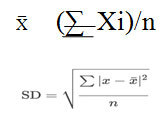
Where,
∑ Summation, X – Individual value in the data set
X̅ Arithmetic mean, n – Number of the data in the set
Results and Discussion
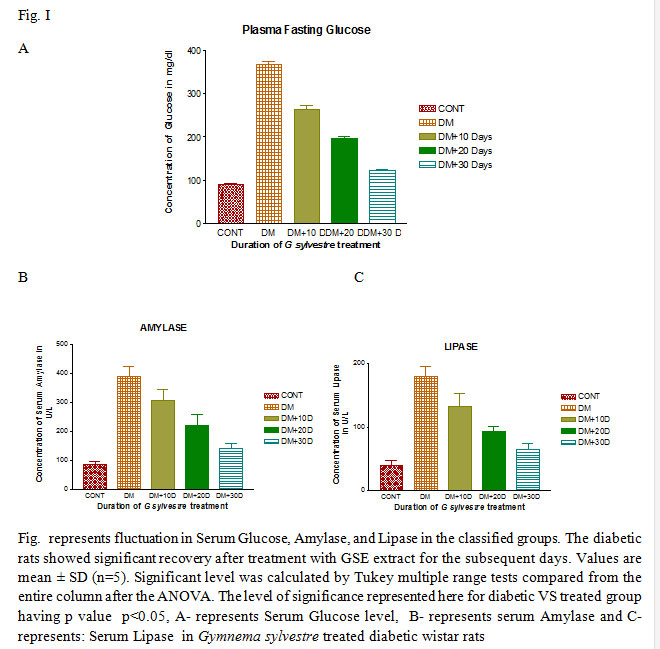 |
Figure 1 |
 |
Figure 2 |
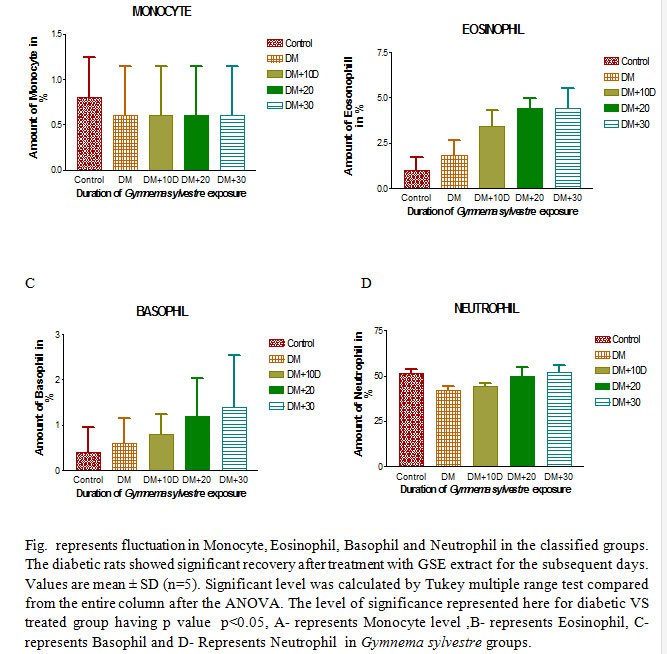 |
Figure 3 |
Rats with Normal and Diabetic Histoarchitecture
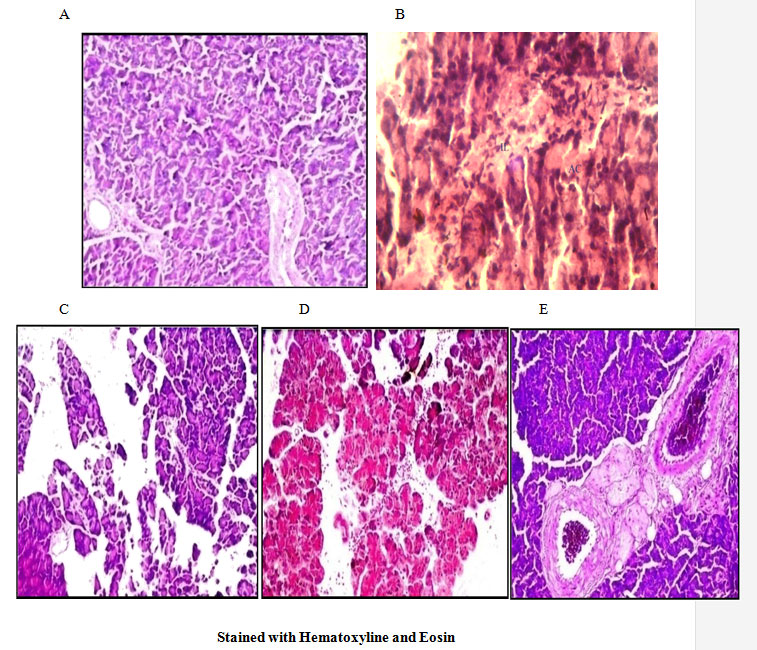 |
Figure 4 |
Rats treated Gymnema sylvestre extract
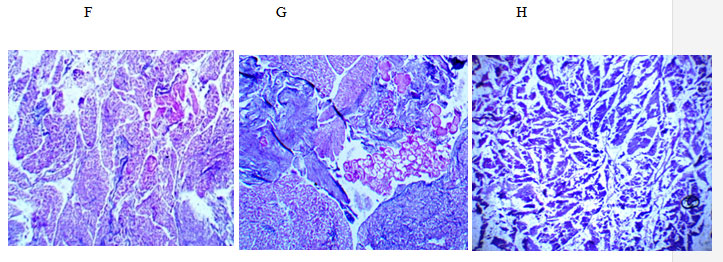 |
Figure 5 |
Stained with Hematoxyline and Eosin
Photomicrograph II
Showing the treatment group G. sylvestre treated group for 10, 20, and 30 days respectively. variable and more intercellular spaces along with deranged ductile system, however concentration of β cell is quite little (F) comparatively Gymnema sylvestre extract has better and much more reduced spaces and ductile system is well developed in 10 days of treatment (F) but as dose prolonged for 30 days the scenario of β cell scanty resolved to a lot of extent (G) & (H)
Discussion
The concentration of plasma glucose plays important role in the diabetes responsible for entire dysregularities and associated complications. 75.54% increase in fasting plasma glucose was registered in diabetic subject however herbal treatment restored the value to to 74% after treatment upto 30th days as compared to normal control (Fig. I). Decrease in blood glucose level registered its significance Histoarchitectural remodeling of pancreas, reduction of Glycation and Its associated complications (Myung-Hwa Kang, et al., 2014). Amylase and lipase pronounces the overall pancreatic exocrine health. Comparatively lipase is more specific to pancreatic as compared to Amylase. The alleviated level of both amylase and lipase in diabetic groups was noticed by 4.50 times that of the normal control while after treatment it was reduced to nearly 1.60 times to that of control
(Fig. I).
Significant recovery was noticed in both the cases and the results obtained registers great importance of the ethanolic extract for control of elevated pancreatic digestive enzyme in diabetes which parallels with the findings of (Thakur et al., 2016, Sellami et al., 2017). Total leucocyte count in diabetic condition was 1.27 times whereas after ethanolic extract administration for 30 days it returned to about 1.02 times that of the normal. (Fig. II), the present outcome satisfies the findings of (Gilad Twig, et.al., 2013). The other possible reason might be the chronic low grade inflammation associated with insulin resistance and type 2 Diabetes; however recovery in presence of herbal extract was significant. Total erythrocyte values are lying in the normal range but towards the lower extreme (Fig. II). The reason behind decrease in the RBC content may be its membranal modification, reduced Na+K+ATPase activity and high lipid peroxidation of the RBC membrane. In an study carried out by (Buys et al., 2013) states decrease in RBC’s average life span. Decrease in the erythrocyte count was displayed by the decreased hemoglobin concentration in diabetic and slight restoration was obtained after the drug administration (Fig. II).
From the above discussion co-relation between hemoglobin and total erythrocyte count was well established. The diabetic rat lymphocyte concentration was 1.28 times to that of normal but with the extract of Gymnema sylvestre it was only 1.02 times to that of the normal (Fig. II). And this slightly increase in the lymphocyte is not a big deal because this is a general phenomenon of the hyperglycemia that individual are more prone to microbial infection. However, after the extract administration as the glucose concentration went down the normalization of lymphocyte also attained. Eosinophil, Monocyte, Basophils, Neutrophils count in the differential section doesn’t draw any peculiar impact of effect of diabetes in the hematological changes except in lymphocyte which was result of opportunistic condition related to infection (Fig. III). The results are Mean ± SD with p<0.05, were calculated using Tukey multiple ranges test, after ANOVA and compared with the entire column.
Present study is also based on the potential of herbal extract and its impact on the diabetic pancreas. A, and B are normal rats histoarchitecture having normal cellular arrangement islet of Langerhans (IL) and Acinar cell (Ac) with well developed vascular and ductile system (Gorczyca et al., 2017). Cells are compact and well mannered, the result agrees with other reports (Aggarwal 2010, Chakraborty et al., 2012). Regeneration and restoration of pancreatic β cell has been the matter of concern. In the current study reduction in the pancreatic β cell mass was noticed along with inflammation, congestion, scattered β cells, neutrophillic excavation showing ruptured blood vessel has been noticed in diabetic subjects (Fig. 1, C, D, and E). Showing the treatment group Gymnema sylvestre treated group for 10, 20, and 30 days respectively. variable and more intercellular spaces along with deranged ductile system, however concentration of β cell is quite little (F) Gymnema sylvestre extract shows significant and much more reduced spaces, congestion (Aralelimath, and Bhise 2012) and ductile system is well developed in 10 days of treatment (I) but as dose prolonged for 30 days the scenario of β cell scanty resolved to a lot of extent ( H) & (K) which co-relates with (Ahmed A B et al., 2010).
Conclusion
The findings in the present study opens several avenues especially in the pancreatic regeneration and dedifferentiation of other cells despite of β- cells, however further clinical trial on humans are required to reach any specific conclusion because the results based on route of administration and intestinal absorption may vary the outcomes. Overall we can say that relying on the herbal formulation from early will certainly reduce the diabetic complication and its prevalence.
Conflict of interest
The authors declare there is no any conflict of interest.
References
Aggarwal BB (2010). Targeting inflammation induced obesity and metabolic diseases by curcumin and other nutraceuticals. Annu Rev Nutri; 30:173-199.
Ahmed A B, Rao A S, Rao M V (2010). In vitro callus and in vivo leaf extract of Gymnema sylvestre stimulate β-cells regeneration and anti-diabetic activity in Wistar rats. Phytomedicine; 17(13):1033-9.
Alexandra E. Butler, Juliette Janson, Susan Bonner-Weir, Robert Ritzel, Robert A. Rizza and Peter C. Butler (2003). β-Cell Deficit and Increased β-Cell Apoptosis in Humans With Type 2 Diabetes. Diabetes ; 52(1):102-10.
Anne M. Minihane, SophieVinoy, Wendy R. (2015). Low-grade inflammation, diet composition and health: current research evidence and its translation, Br J Nutr ; 114(7): 999–1012.
Aralelimath, V.R.; Bhise, S.B. (2012) Anti-diabetic effects of Gymnema sylvestre extract on streptozotocin induced diabetic rats and possible β-cell protective and regenerative evaluations. Dig. J. Nanomater. Biostruct., v.7, p.135-142.
Azari, Elnaz Karimian, Kathleen R Smith, Fanchao Yi, Timothy F Osborne, Roberto Bizzotto, Andrea Mari, Richard E Pratley, and George A Kyriazis (2017). Inhibition of sweet chemosensory receptors alters insulin responses during glucose ingestion in healthy adults: a randomized crossover interventional study, Am J Clin Nutr; 105(4):1001-1009.
Ballian, N., and Brunicardi, F.C (2007), Islet vasculature as a regulator of endocrine pancreas function. World J Surg; 31(4): pp. 705–14.
Buys AV, Van Rooy MJ, Soma P, Van Papendorp D, Lipinski B, Pretorius E (2013): Changes in red blood cell membrane structure in type 2 diabetes: a scanning electron and atomic force microscopy study. Cardiovasc Diabetol; 10.1186/1475-2840-12-25.
Cesmebasi A, Malefant J, Patel SD, Du Plessis M, Renna S, Tubbs RS, Loukas M (2015). The surgical anatomy of the lymphatic system of the pancreas. Clin Anat; 28(4):527-37.
Chakraborty D, Mukherjee A, Sikdar S, Paul A, Ghosh S, Khuda- Bukhsh AR (2012). [6]-Gingerol isolated from ginger attenuates sodium arsenite induced oxidative stress and plays a corrective role in improving insulin signaling in mice. Toxicolo Letters; 210: 34-43.
Chandirasegaran G, Elanchezhiyan C, Ghosh K, Sethupathy S (2017). Berberine chloride ameliorates oxidative stress, inflammation and apoptosis in the pancreas of Streptozotocin induced diabetic rats Biomed Pharmacother. ;95:175-185.
Chen C, Cohrs CM, Stertmann J, Bozsak R, Speier S (2017) Human beta cell mass and function in diabetes: Recent advances in knowledge and technologies to understand disease pathogenesis. Mol Metab; 6(9):943-957
Covantev S, Mazuruc N, Belic O (2019). The Arterial Supply of the Distal Part of the Pancreas. Surg Res Pract. 5804047.
Dotz V, Lemmers RFH, Reiding KR, HipgraveEderveen AL, Lieverse AG, Mulder MT, Sijbrands EJG, Wuhrer M, van Hoek M(2018). Plasma protein N-glycan signatures of type 2 diabetes. Biochim Biophys Acta Gen Subj; 1862(12):2613-2622.
Dunn JS, Sheehan HL, McLetchie NGB (1943). Necrosis of islet of Langerhan’s produced experimentally. Lancet; 1;484-487
Gastaldelli A, Nauck MA, Balena R (2013). Eight weeks of treatment with long-acting GLP-1 analog taspoglutide improves postprandial insulin secretion and sensitivity in metformin-treated patients with type 2 diabetes. Metabolism; 62(9):1330-9.
Gilad Twig, Arnon Afek, Ari Shamiss, Estela Derazne, DoritTzur, Barak Gordon, and Amir Tirosh (2013). White Blood Cells Count and Incidence of Type 2 Diabetes in Young Men. Diabetes Care; 36(2):276-82
Gorczyca J, Tomaszewski KA, Henry BM, Pękala PA, Pasternak A, Mizia E, Walocha JA (2017). The Vascular Microarchitecture of the Human Fetal Pancreas: A Corrosion Casting and Scanning Electron Microscopy Study.Pancreas; 46(1):124-130.
Hooda A, Mehta A, Hannallah F (2019). Metformin-associated lactic acidosis precipitated by liraglutide use: adverse effects of aggressive antihyper glycaemic therapy. Drug Ther Bull; 57(7):109-111.
Korc M, Iwmoto Y, Sankaran H, Williams J A, Goldfine I D, (1981). Insulin action in pancreatic acini from streptozotocin-treated rats. I. Stimulation of protein synthesis. Am J Physiol; 240(1): pp. G56–62.
Korc, M., Sankaran H, Wong K Y, Willians J A, Goldfine I D, (1978). Insulin receptors in isolated mouse pancreatic acini. BiochemBiophys Res Commun; 84(2): pp. 293–9.
Kumud Ranjan Thakur, S. R. Padmadeo, Bipin Bihari Mishra and Kumar Pranay (2016). Study of ameliorating properties of Tinospora cordifolia on Diabetes and acute Pancreatitis in Alloxan treated Rats, Der Pharmacia Lettre, 8 (18):133-140.
Leahy JL (2005). Pathogenesis of type 2 diabetes mellitus. Arch Med Res. (3):197-209.
Longnecker, Daniel (2004) Anatomy and Histology of the pancreas. Pancreapaedia: Exocrine Pancreas Knowlegde base DOI: 10.3998/panc. 2014.3
Maiti R, Jana D, Das UK, Ghosh D (2004). Antidiabetic effect of aqueous extract of seed of Tamarindus indica in streptozotocin-induced diabetic rats. J Ethnopharmacol; 92(1):85-91.
Myung-Hwa Kang, Min Sun Lee, Mi-Kyeong Choi, Kwan-Sik Min, Takayuki Shibamoto (2014) Hypoglycemic Activity of Gymnema sylvestre Extracts on Oxidative Stress and Antioxidant Status in Diabetic Rats. J. Agric. Food Chem; 60,10, 2517-2524
Patel MB, Mishra S (2011). Hypoglycemic activity of alkaloidal fraction of Tinospora cordifolia. Phytomedicine;18(12):1045-52.
Ruiz HH, López Díez R, Arivazahagan L, Ramasamy R, Schmidt AM (2019). Metabolism, Obesity, and Diabetes Mellitus. Arterioscler Thromb Vasc Biol ; 39(7):e166-e174
Saltiel AR, Olefsky JM (2017). Inflammatory mechanisms linking obesity and metabolic disease. J Clin Invest ; 127(1):1-4
Sellami M, Louati H, Kamoun J, Kchaou A, Damak M, Gargouri Y (2017). Inhibition of pancreatic lipase and amylase by extracts of different spices and plants. Int J Food Sci Nutr; 68(3):313-320.


